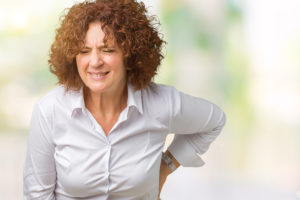Spondylosis Treatment From Spine Care Specialists in Freehold, NJ
Reviewed by AOSMI’s Fellowship-Trained Orthopedic Spine Surgeon, Dr. Justin Elkrief.
WHAT IS SPONDYLOSIS?
 Spondylosis is a technical term for osteoarthritis of the spine, a common condition that often develops along with the natural aging process. Over the years, the effects of wear and tear from daily activities can take a toll on the spine, causing its components to gradually break down. For instance, the cushioning discs that separate the vertebrae can begin to dry out and flatten, allowing the spinal bones to move closer together and possibly leading to painful bone-on-bone contact. In response, the body may produce protective bony deposits (bone spurs), which can potentially press on a sensitive spinal nerve root.
Spondylosis is a technical term for osteoarthritis of the spine, a common condition that often develops along with the natural aging process. Over the years, the effects of wear and tear from daily activities can take a toll on the spine, causing its components to gradually break down. For instance, the cushioning discs that separate the vertebrae can begin to dry out and flatten, allowing the spinal bones to move closer together and possibly leading to painful bone-on-bone contact. In response, the body may produce protective bony deposits (bone spurs), which can potentially press on a sensitive spinal nerve root.
What are the symptoms of spondylosis?
In addition to neck and back pain, spondylosis can cause the following symptoms:
- Stiffness
- Muscle weakness
- Numbness
- Tingling sensations
Because other medical conditions can cause these symptoms as well, it’s important to receive an accurate diagnosis from an orthopedic doctor before seeking spine care for spondylosis.
How is spondylosis treated?
While there is no cure for spondylosis, its symptoms can often be managed. The spine specialists at Advanced Orthopedics and Sports Medicine Institute offer a full range of spinal osteoarthritis treatment options at our state-of-the-art medical center in Freehold, NJ.
- Resistance training with weights or rubber bands to strengthen the muscles that support the spine
- Range-of-motion exercises to improve spinal flexibility
- Therapeutic massage to loosen tense muscles and ease spasms
- Cold therapy to reduce swelling
- Heat therapy to promote relaxation
- Transcutaneous electrical nerve stimulation (TENS) to stimulate the release of endorphins (the body’s natural pain-relieving hormones)
- Over-the-counter or prescription-strength pain relievers and nonsteroidal anti-inflammatory drugs (NSAIDs) to alleviate painful inflammation
- Epidural steroid injections to target severe inflammation
- Facet thermal ablation to desensitize the affected nerves and smooth the bony projections
In most cases, spondylosis can be treated without surgery. However, if bladder or bowel function is impaired, the nervous system is damaged, or walking becomes very difficult, spondylosis surgery option may be discussed.
SPONDYLOSIS TREATMENT AT AOSMI
If you’re experiencing spondylosis symptoms, take your first step toward finding relief by scheduling an appointment with an orthopedic spine surgeon at AOSMI in Freehold, New Jersey. After we confirm your diagnosis, we can provide personalized advice on the most appropriate type of spine care to help you feel better, faster.
FREQUENTLY ASKED QUESTIONS ABOUT SPONDYLOSIS
What is the difference between spondylosis vs spondylolisthesis?
What are the different types of spondylosis?
What spondylosis exercises can I do at home?
What causes spondylosis pain to flare up?
What is the most common age for spondylosis?
FREQUENTLY ASKED QUESTIONS ABOUT SPONDYLOSIS
What is the difference between spondylosis vs spondylolisthesis?
Spondylosis refers to the general degenerative changes that occur in the spine over time, including the wear and tear of spinal discs, joints, and ligaments. Spondylolisthesis, on the other hand, specifically involves the forward slippage of one vertebra over another. While spondylosis encompasses various age-related degenerative changes, spondylolisthesis is a specific condition where the slippage of a vertebra occurs due to structural defects or instability.
What are the different types of spondylosis?
There are different types of spondylosis based on the affected region of the spine:
1. Cervical Spondylosis: Degeneration in the cervical spine (neck area).
2. Lumbar Spondylosis: Degeneration in the lumbar spine (lower back area).
3. Thoracic Spondylosis: Degeneration in the thoracic spine (mid-back area).
These types of spondylosis involve the breakdown of spinal discs, facet joints, and other spinal structures, leading to pain and reduced spinal function.
What spondylosis exercises can I do at home?
It’s important to consult a healthcare professional before starting any exercise program for spondylosis. However, gentle exercises that focus on improving flexibility, strengthening core muscles, and enhancing posture may be beneficial. Examples include pelvic tilts, knee-to-chest stretches, cat-cow stretches, and gentle aerobic activities like walking or swimming. A physical therapist can provide personalized guidance on safe and effective exercises.
What causes spondylosis pain to flare up?
Spondylosis pain may flare up due to various factors, including:
- Overexertion or improper lifting techniques
- Prolonged poor posture
- Repetitive movements or activities that strain the spine
- Sudden movements or trauma
- Cold weather or changes in atmospheric pressure
- Excessive weight gain or obesity
Identifying and avoiding triggers, maintaining proper body mechanics, and practicing a healthy lifestyle can help minimize the risk of pain flare-ups.
What is the most common age for spondylosis?
Spondylosis is a degenerative condition that becomes more common as people age. It is most prevalent in individuals over the age of 50. However, early signs of spondylosis can develop earlier, and the condition may progress over time. Factors such as genetics, lifestyle, and previous injuries can also influence the onset and progression of spondylosis.
Find your Provider










